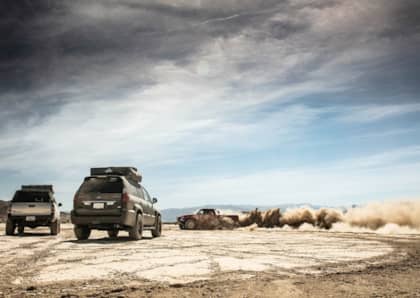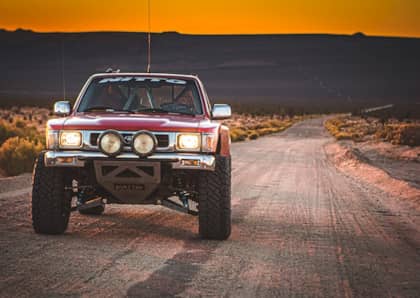Top 10 Things to Check BEFORE Hitting the Trail
Off-roading and adventure enthusiasts know that exploring the great outdoors in a 4x4 truck or SUV can be an exhilarating experience. However, it's also a fact that off-road vehicles are subjected to harsh conditions that can put a strain on their components and lead to unexpected breakdowns. To avoid these unfortunate situations, a thorough pre-trip inspection is essential.
In this article, we'll provide you with a comprehensive checklist of the top 10 parts and components to inspect before embarking on your next off-road adventure. By following these guidelines, you can spend more time enjoying the trail and less time dealing with damage and repairs.

1. Inspect Your Off-Road Tires
Off-road tires are your vehicle's connection to the trail, making them one of the most critical components to check. Look for obvious signs of impending tire failure, such as sidewall slices, deep cuts in the tread, punctures, or previous repairs that may be failing. Also, check the age of your tires to ensure they aren't dry-rotted with cracks. Pay attention to tread separation, cupping, or uneven wear, as these issues can signal problems with your suspension or alignment. Don't forget to inspect your spare tire. It's your backup in case of a flat, so make sure it's in good condition before hitting the trail.

2. Torque Down Suspension Nuts and Bolts
Regular maintenance of your vehicle's suspension components is crucial, especially if you do a lot of off-roading. The constant stresses and impacts can lead to loose bolts and nuts. It's a good practice to follow the manufacturer's torque specifications for your suspension, steering, and drivetrain components. Consider using a torque seal to mark the hardware after tightening it. This helps you easily identify any loosening during subsequent inspections.

3. Check Differential and Transfer Case Fluids
Your 4x4 vehicle relies on various fluids, including front differential gear oil, transfer case gear oil, and rear differential gear oil. Regularly check these fluids to ensure they are at the proper levels and replace them at the recommended intervals. Maintaining these vital drivetrain components will help prevent gear failures when off-roading.

4. Look for Leaks Under Your Off-Road Vehicle
Inspect your vehicle's underside for any signs of fluid leaks. Leaks can be detrimental, even if they don't result in puddles on the ground. Visual inspection is essential to detect potential issues early and avoid problems on the trail.

5. Clean Your Air Filter After Off-Roading
Off-roading can quickly clog your air filter with dust and debris. Consider using a serviceable air filter rather than oilable ones, which can attract more dirt. Keeping your air filter clean helps your engine breathe better, leading to improved fuel efficiency, too.

6. Look for Leaking Shocks
Shocks, whether stock or aftermarket, contain oil to dampen the ride. Over time, the seals can degrade, leading to leaking shocks. Before your trip, visually inspect all four shocks for any residue, dust, or signs of leaks. Address any leaking shocks promptly by replacing or rebuilding them.

7. Off-Road Brake Inspection
Proper brake function is vital for off-roading, particularly in steep or rugged terrain. Check your brake fluid reservoir to ensure it's at the recommended level. Inspect the entire brake system for cracks, wear, and tear. Pay special attention to rubber brake lines, as they can dry out quickly. Verify the condition of brake pads, rotors, and calipers to ensure your brakes are in optimal working order.

8. Check for Bad Driveshaft U-Joints
Frequent inspection of your driveshaft and U-joints is essential, as a failing U-joint can leave you stranded on the trail. Visually inspect the U-joints by gently shaking the driveshaft while the vehicle is in neutral on flat ground. Any excessive play should prompt U-joint replacement or driveshaft servicing.

9. Inspecting Hoses and Belts
Hoses and belts are prone to wear and tear, so it's essential to visually inspect them for dry rot, cracking, or leaks. Any issues with hoses or belts can lead to major problems when you're far from civilization. It's better to replace them as a preventive measure than to deal with a breakdown on the trail.

10. Look for Frame Cracks
For body-on-frame vehicles, checking the frame for cracks or stress fractures is vital. A few minutes spent inspecting your vehicle's frame before a trip can save you from facing a more significant problem far from help. Cracks or fractures in the frame can be extremely challenging to repair on the trail.

Final Thoughts
By following this comprehensive pre-trip checklist, you can significantly reduce the chances of experiencing breakdowns while off-roading. While it may seem like a lengthy process, these checks can ultimately save you time, money, and frustration when exploring the great outdoors. Prioritizing regular maintenance and inspections will ensure that your off-road adventures are enjoyable and worry-free. So, before your next off-roading trip, take the time to inspect these critical components, and remember that preparedness is key to a successful journey into the wild.











